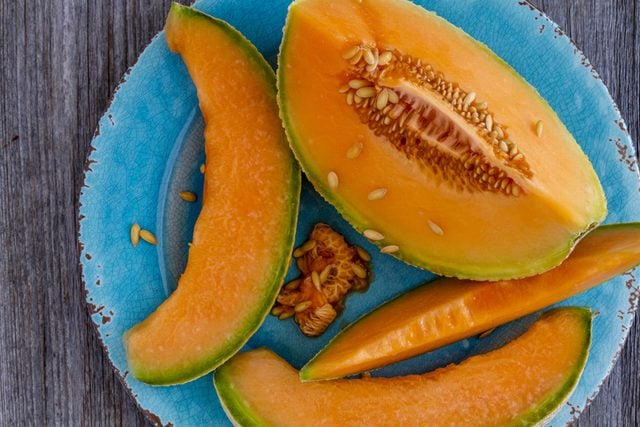This Is Why Melons Can Go for $125 in Japan
Updated: Mar. 29, 2021
Some are as expensive as a car.

Cantaloupe might show up in just about every American fruit salad, but fruits are a luxury in Japan. A pair of Yubari King melons even sold for more than $27,000 at an auction in 2016. Yep, enough to buy a new car instead of a rare cantaloupe. What could possibly justify such a wild price tag?
While Americans tend to eat apples and oranges as everyday nutritious snacks, Japanese fruit is way more expensive. Even when families treat themselves to apples, they’ll usually split one fruit between everyone rather than chomp into one alone. Buddhists leave fruits as offerings to the gods, and that practice has led the food group to be seen as a symbol of respect, according to CNN. Gift-giving is an important part of Japanese culture—whether for a boss, for a host, or as a thank-you—and fruits are a common choice for showing status. (Find out what happens to your body when you don’t eat enough fruits and vegetables.)
These aren’t your typical fruit baskets, though. Paying $27,000 at an auction isn’t the norm, but even a typical Tokyo supermarket, plain old apples can cost more than $2. The difference is that you won’t find the bruised and misshapen ones you might see at an American grocery store. Only the most beautiful fruits will make it on the shelves, according to BBC. (Next time you’re grocery shopping, pick up these 10 healthiest fruits.)
Some sellers, like Japan’s biggest high-end fruit provider Sembikiya, take it a step beyond, even for Japan’s sky-high standards. At the luxury fruit store, you’ll find $19 pears, $24 apples, and the crown fruit: $125 muskmelons. The Sembikiya melons—a cousin of cantaloupe—sound wildly overpriced, but the care that goes into each fruit explains why they’re so pricy.
Before even starting to grow a muskmelon, farmers select the best seeds to plant in a greenhouse, according to Slate. As soon as the plants start to flower, the farmers remove any subpar buds and pollinate the nicest blooms by hand with a paintbrush. Once the fruits begin to develop, only the strongest will survive. Farmers take all but the single best melon off each vine so the fruit won’t need to compete with others for nutrients.
The muskmelons that made it that far get even more special treatment as they ripen. Growers tie a string around their stems so they don’t fall before they’re ready for harvest, and prune every vine to the exact same height. The fruits get decked out with a cone-shaped black “hat” that protects them from sunburn. Each individual fruit gets a special massage, too. Wearing white gloves, farmers give each fruit a “ball wiping,” as the Sembikiya website calls it. Supposedly, rubbing the fruit helps shape it into a perfect sphere and promotes a more beautiful “net” on the skin.
“I believe this is the most labor-intensive method out of all the melon farming all over Japan,” grower Masaomi Suzuki tells BBC. “We call it the Shizuoka method. In other places they do it differently and get multiple melons from each vine. But this takes by far the most effort.” Suzuki says he and his family have never taken a vacation together because someone always needs to be there keeping an eye on the harvest.
Once the fruits are ready to be eaten, Sembikiya is exceptionally picky about which fruits it will sell. It judges each fruit on roundness, netting intricacy, sweetness, and scent. Only about 3 percent of any given harvest will be considered high enough quality, and just a select few of those muskmelons will actually make it onto the shelves. Even if you’re not quite that picky about your fruit, learn how to choose the best watermelon.
Not that Sembikiya is the only place you can find (arguably) overpriced fruits. For one foodie trend, growers will force otherwise-normal watermelon into cool shapes like hearts or cubes. Those fruits will for as much as $860 overseas, and $1,500 in Japan. Supposedly they were grown as a space issue—cubes are much easier to fit in a fridge than an awkward, oversized round melon—but ones that arrived in Russia weren’t even ripe yet. (Learn why watermelon is one of the 12 most filling fruits and vegetables.)
We’re all for getting excited about fruit, but for now we’ll be sticking to our cheap supermarket findings. Learn which healthy swaps can save you money on your grocery bill.
[Source: The Independent]